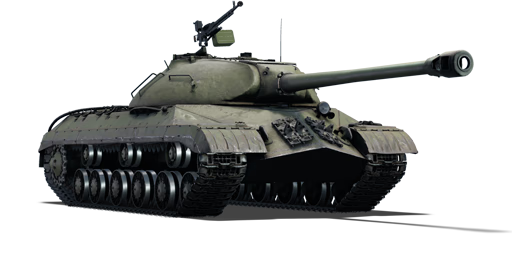



The IS-3 is the third variant of the IS heavy tank family. The IS-3 featured a revolutionary front hull and turret design that would become the trademark of all postwar Soviet tanks until this day. Since the IS-3 differed from earlier designs in many ways, a thorough retooling was required for the first time. This took time, and the first three IS-3s rolled out of the factory in May 1945, ready to go into service in Germany under an independent Guards Battalion. When they arrived, though, the peace treaty had already been signed. Many more IS-3s were ready by the time of the August invasion of Manchuria, but there is little indication that they took part in these events. In the end, the IS-3 saw little action other than being stationed on numerous fronts during the Cold War. Due to a variety of difficulties, production was halted, and it was replaced with the IS-4, prototypes IS-6, IS-7, and, finally, the IS-8 (renamed T-10 after Stalin's death). Because of their lack of mobility, the Russians came to the same conclusion as their Western counterparts about heavy tanks. After the first MBT family was launched in 1953, this class of heavy tank was also abandoned, similar to those in the West.
Introduced in the Closed Beta Test for Ground Forces before Update 1.41, the IS-3 is armed with the same 122 mm D-25T tank gun as earlier IS heavy tank variants, which has incredible destructive power. Once the BR-471D ammunition becomes available, the weapon's efficacy increases dramatically, increasing its penetration from 207 to 230 mm. The IS-3 will face several other heavy tanks with huge, slow-reloading guns in its ranks, establishing an equal playing field. Regardless, be wary of nimble, fast-firing, lightly armoured flanking opponents. Despite being relatively light for a heavy tank, the IS-3 has poor mobility. It features a 671-horsepower engine, which makes the vehicle feel slow while attempting to initiate a turn from both a standstill and when moving. Its acceleration is likewise lacking; nonetheless, it has a reasonably high top speed and will usually reach it regardless of the surface it is driving on. Fortunately, as with many late Soviet heavy tanks, the IS-3's reverse speed is highly respectable, giving it the time it needs to back out of dangerous circumstances to reload or repair. Despite what some may expect from such a massive tank, the reverse gears and low forward gears allow the vehicle to drive up unexpectedly steep slopes.
The most noticeable differences between the preceding variants are the revised turret and the sharply slanted 'pike' nose. The front is not just slanted but also relatively thick, with 110 mm of armour on both the top and bottom, oriented at 54°, -56°, and 54°, respectively. The IS-3, like previous variants, has fairly mediocre side and rear armour, therefore, angling should be avoided. The turret has been modified to be considerably stronger than previous variants, with more angling, a much smaller flat region around the mantlet, and significantly thicker casting. Trap shots and turret ring penetration are possible; however, they can be mitigated by lowering the tank gun and protecting the vulnerable locations. The IS-3 is a 'breakthrough' tank that excels at close-range, front-on combat where flanking is unlikely and players can take advantage of the strong frontal armour and reverse speed to deliver surprising blows to the enemies.
| Ammunition | Type | Armor penetration (mm) at a distance: | |||||
|---|---|---|---|---|---|---|---|
| 10 m | 100 m | 500 m | 1000 m | 1500 m | 2000 m | ||
| APHE | 205 | 201 | 182 | 161 | 143 | 126 | |
| HE | 37 | 37 | 37 | 37 | 37 | 37 | |
| APHEBC | 205 | 203 | 192 | 178 | 166 | 155 | |
| APCBC | 230 | 227 | 215 | 200 | 186 | 173 | |
| Belt | Belt filling | Armor penetration (mm) at a distance: | |||||
|---|---|---|---|---|---|---|---|
| 10 m | 100 m | 500 m | 1000 m | 1500 m | 2000 m | ||
| API-T/IAI/API-T/AP-I(c) | 34 | 32 | 24 | 17 | 12 | 8 | |
| Belt | Belt filling | Armor penetration (mm) at a distance: | |||||
|---|---|---|---|---|---|---|---|
| 10 m | 100 m | 500 m | 1000 m | 1500 m | 2000 m | ||
| AP-I/API-T | 13 | 12 | 7 | 3 | 2 | 0 | |












Mobility | |
|---|---|
Protection |
|---|
Firepower | |
|---|---|